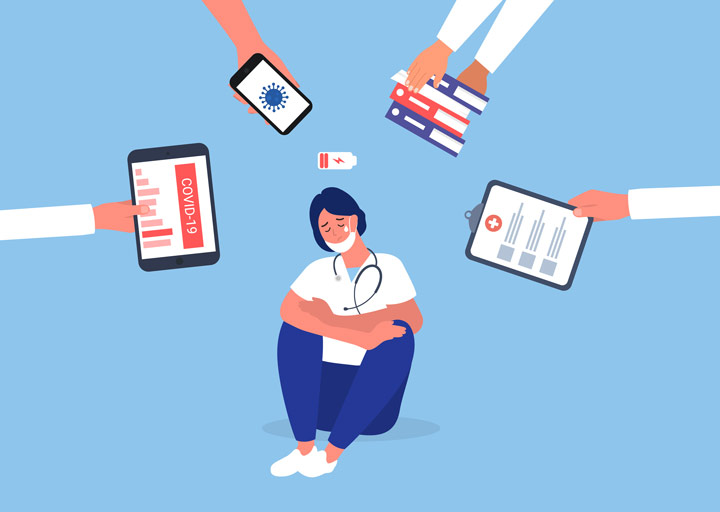Ever wonder why nurses are leaving? Look no further.
Not only has technology failed to give nurses more time with their patients at the bedside, but it also has failed to reduce the number of tasks performed or to decrease multitasking.
While updating speech material this week, I was reminded of Anita Tucker’s work from 2006, which found that nurses:
- were interrupted mid-task eight times a shift
- experience more than 8 work failures per shift (missing medication, equipment, etc.)
- perform over 160 tasks in an 8-hour shift—each averaging 2 minutes and 45 seconds
- have 7 to 8 items staked at any given time (that mental list we hold in our heads).
This may explain why when we get home from work, we remember that we forgot to give tissues to the patient in 64 or to include the blood hung for 58 in the Is and Os. This is because our frontal cortex was overloaded at work and the synapses finally have time to connect when we’re not in constant motion.
Fast forward 14 years later. Yen and colleagues found that instead of 160 tasks in an 8-hour shift, nurses now perform 416!
- Average of 124 communications and 208 tasks in a 4-hour block of time (416 in 8 hours)
- Multitasking (defined as communications and tasks) 131 times or 40% of the time
Add to this insanity the impact of the pandemic where 44% of nurses reported experiencing physical violence and 68% reported verbal abuse—and no one should be wondering why nurses are leaving. According to Byon and colleagues, nurses who provided care for patients with COVID-19 experienced higher rates of violence and were two to four times more likely to experience post-traumatic stress disorder, anxiety, depression, and burnout than nurses with no exposure. And let’s just add to this gross inequity by realizing that you’re working along a traveler who’s making twice your salary for the same job.
Nurses are tired of being extorted by a health system masquerading as a service but operating as big business whose incentives aren’t aligned with their values. CEOs make millions and are pushing out initiatives on productivity while nurses work short staffed in most hospitals without meals or breaks. (Yesterday a nursing leader just told me she is not allowed to say “nursing departments.” She is required to say “business units.” You got that right.)
The human adaptability theory states that changes that occur slowly over time aren’t noticed by humans (similar to the fish in hot water metaphor). In my last shift worked, I floated to another floor outside my expertise and struggled to give (on-time) 35 scheduled medications. I had never heard of 18 of them and tried desperately to look them all up.
One of the best things about human beings is that we’re adaptable.
One of the worst things about us is that we’re adaptable.
What have nurses adapted to?
I challenge technology leaders to turn this around. To measure success by increasing the time a nurse has with a patient and to give nurses time to think critically and to process.
I challenge hospital administrators to pay nurses for 10-hour shifts of which 8 hours are clinical and 2 are the time they need and deserve for the thought processes and activities that enhance their profession: education, follow-up, and safety and quality improvements.
This insane work pace is unparalleled in any other industry. And it’s unacceptable.
References
Byon HD, Sagherian K, Kim Y, Lipscomb J, Crandall M, Steege L. Nurses’ experience with Type II workplace violence and underreporting during the COVID-19 pandemic. Workplace Health Saf. 2021 doi:10.1177/21650799211031233
Tucker AL, Spear SJ. Operational failures and interruptions in hospital nursing. Health Serv Res. 2006;41(3 Pt 1):643-62. doi:10.1111/j.1475-6773.2006.00502.x
Yen PY, Kellye M, Lopetegui M, et al. Nurses’ time allocation and multitasking of nursing activities: A time motion study. AMIA Annu Symp Proc. 2018:1137-46.
Yen PY, Kelley M, Lopetegui M, et al. Understanding and visualizing multitasking and task switching activities: A time motion study to capture nursing workflow. AMIA Annu Symp Proc. 2017;2016:1264-73.


All of her books come from her passion to understand the stories of nurses. Her books, “Ending Nurse to Nurse Hostility” and “Speak Your Truth” illuminate our relationships with our peers and physician partners. She is also co-author of “The Dauntless Nurse” which was written as a communication confidence builder.
Kathleen is also a guest Op Ed writer to the Seattle Times and has been interviewed twice on NPR’s “People’s Pharmacy”. Her Tedx Talk calls for changing our belief system from a hierarchy to equality in order to keep our patients safe – and also explains how disaster thrust her into ‘the best profession ever’.
You can also find more information about Kathleen on her website, Twitter, and Facebook.



















1 Comment. Leave new
Thank you for calling out technology – it seems like it has become part of the profession that “cannot be changed”. I’ve passed this along so that this can be part of our next strategic planning in Nursing!